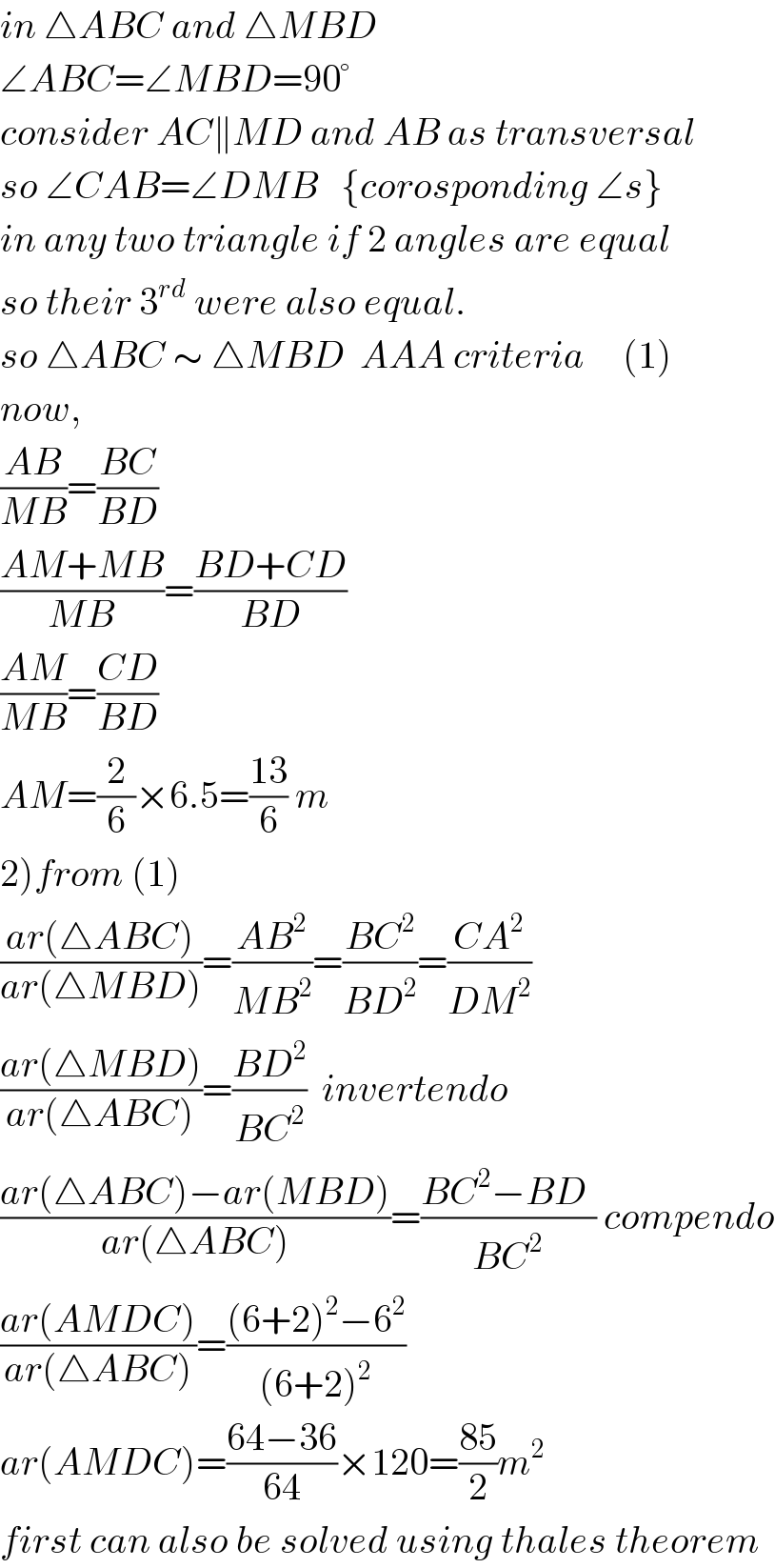Question Number 49605 by Rio Michael last updated on 08/Dec/18

Commented by Rio Michael last updated on 08/Dec/18

$${The}\:{figure}\:{above}\:{has}\:\bigtriangleup{ABC}\:{and}\:\bigtriangleup{MBD}\:{where}\:{AC}\:{is}\:{parallel} \\ $$$${to}\:{DM}.{Find}\:{the}\:{lenght}\:{AM}\:{if} \\ $$$$\left.{a}\right)\:{BM}\:=\:\mathrm{6}.\mathrm{5}{m} \\ $$$$\left.{b}\right)\:{Given}\:{the}\:{the}\:{area}\:{of}\:\bigtriangleup{ABC}\:=\:\mathrm{120}{m}^{\mathrm{2}} \:{find}\:{the}\:{area} \\ $$$${of}\:{the}\:{Trapezium}\:{ACDM}. \\ $$
Commented by afachri last updated on 08/Dec/18

$$\mathrm{what}\:\mathrm{is}\:\mathrm{CD}\:\mathrm{sir}\:???\: \\ $$$$\mathrm{can}'\mathrm{t}\:\mathrm{see}\:\mathrm{it}\:\mathrm{sir}. \\ $$
Commented by Rio Michael last updated on 08/Dec/18

$${CD}=\:\mathrm{2}{m} \\ $$
Answered by Kunal12588 last updated on 08/Dec/18

$${in}\:\bigtriangleup{ABC}\:{and}\:\bigtriangleup{MBD} \\ $$$$\angle{ABC}=\angle{MBD}=\mathrm{90}° \\ $$$${consider}\:{AC}\parallel{MD}\:{and}\:{AB}\:{as}\:{transversal} \\ $$$${so}\:\angle{CAB}=\angle{DMB}\:\:\:\left\{{corosponding}\:\angle{s}\right\} \\ $$$${in}\:{any}\:{two}\:{triangle}\:{if}\:\mathrm{2}\:{angles}\:{are}\:{equal} \\ $$$${so}\:{their}\:\mathrm{3}^{{rd}} \:{were}\:{also}\:{equal}. \\ $$$${so}\:\bigtriangleup{ABC}\:\sim\:\bigtriangleup{MBD}\:\:{AAA}\:{criteria}\:\:\:\:\:\left(\mathrm{1}\right) \\ $$$${now}, \\ $$$$\frac{{AB}}{{MB}}=\frac{{BC}}{{BD}} \\ $$$$\frac{{AM}+{MB}}{{MB}}=\frac{{BD}+{CD}}{{BD}} \\ $$$$\frac{{AM}}{{MB}}=\frac{{CD}}{{BD}} \\ $$$${AM}=\frac{\mathrm{2}}{\mathrm{6}}×\mathrm{6}.\mathrm{5}=\frac{\mathrm{13}}{\mathrm{6}}\:{m} \\ $$$$\left.\mathrm{2}\right){from}\:\left(\mathrm{1}\right) \\ $$$$\frac{{ar}\left(\bigtriangleup{ABC}\right)}{{ar}\left(\bigtriangleup{MBD}\right)}=\frac{{AB}^{\mathrm{2}} }{{MB}^{\mathrm{2}} }=\frac{{BC}^{\mathrm{2}} }{{BD}^{\mathrm{2}} }=\frac{{CA}^{\mathrm{2}} }{{DM}^{\mathrm{2}} } \\ $$$$\frac{{ar}\left(\bigtriangleup{MBD}\right)}{{ar}\left(\bigtriangleup{ABC}\right)}=\frac{{BD}^{\mathrm{2}} }{{BC}^{\mathrm{2}} }\:\:{invertendo} \\ $$$$\frac{{ar}\left(\bigtriangleup{ABC}\right)−{ar}\left({MBD}\right)}{{ar}\left(\bigtriangleup{ABC}\right)}=\frac{{BC}^{\mathrm{2}} −{BD}^{} }{{BC}^{\mathrm{2}} }\:{compendo} \\ $$$$\frac{{ar}\left({AMDC}\right)}{{ar}\left(\bigtriangleup{ABC}\right)}=\frac{\left(\mathrm{6}+\mathrm{2}\right)^{\mathrm{2}} −\mathrm{6}^{\mathrm{2}} }{\left(\mathrm{6}+\mathrm{2}\right)^{\mathrm{2}} } \\ $$$${ar}\left({AMDC}\right)=\frac{\mathrm{64}−\mathrm{36}}{\mathrm{64}}×\mathrm{120}=\frac{\mathrm{85}}{\mathrm{2}}{m}^{\mathrm{2}} \\ $$$${first}\:{can}\:{also}\:{be}\:{solved}\:{using}\:{thales}\:{theorem} \\ $$
Commented by Rio Michael last updated on 08/Dec/18

$${thanks}\:{sir} \\ $$
